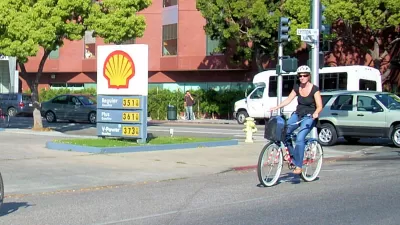Opposition is stirring in industry and within the California legislature over the inclusion of oil refineries* in the cap and trade program come Jan. 1. Warning of a new tax on gas, opponents hope to delay the requirement for transportation fuels.
(*Updated 07/11/2014) Calling it the "new gas tax," a "bipartisan group of local lawmakers are joining business groups in a campaign" to oppose the inclusion of transportation fuels in California's successful cap and trade program as "they say will lead to higher gas and goods costs for consumers," writes Neil Nisperos of the Inland Valley Daily Bulletin.
“If this goes through as planned, in places like the Valley and other communities where money’s tight, another 15 cents a gallon?” said Henry Perea, the (Democrat) Fresno assemblyman who wrote a letter signed by 16 Democrats this month to Mary Nichols, chairwoman of the California Air Resources Board (CARB), writes Dave Siders in the Sacramento Bee.
Perea "introduced legislation through Assembly Bill (AB) 69, which would delay putting fuels under the cap-and-trade program until January 1, 2018," according to his press release. [Technical note: this is known as a "gut and amend" as he amended an existing bill rather than draft a new bill.]
Authorized by the state's landmark climate change law, AB 32 in 2006, and approved by CARB in 2011, it took effect in 2012, primarily with power plants and other large industrial emitters which purchased emission allowances when necessary. On January 1, oil refineries* [ed: see correction below] will enter the program—and that has many state legislators of both parties concerned that gas prices could be raised steeply.
The lawmakers and industry opponents are being supported through an online campaign at www.tankthetax.com.
"It sounds like in an election year everyone is looking for some political cover on tough issues," said Robin Swanson, a Democratic political consultant. "If gas prices go up in the summer, no one wants to be held accountable for that; no one wants to be left holding that bag," writes Siders.
Senate leader Darrell Steinberg had hoped to add a carbon tax to gasoline in lieu of placing transportation fuels under cap and trade as we noted previously, but he dropped that effort. "In essence, the decision (was) whether to charge consumers at the pump or have refineries participate in a carbon auction, and pass on the added costs to consumers."
How revenues from cap and trade would be spent was determined in the state's new budget, posted here. While high speed rail captured much media attention, transit and affordable housing were big winners as well. If opponents succeed, that budget will likely have to be revised.
Finally, the largest source (40%) of carbon emissions in California is from transportation. Not having transportation fuels included in the cap and trade program would jeopardize the goal of AB 32—to reduce carbon emissions to 1990 levels by 2020.
*Correction per Air Resources Board: "Oil refineries have been under cap-and-trade since compliance began in 2013. On January 1, 2015, suppliers of transportation fuel and natural gas come into the program. These are operations which distribute fuel."
*Correction: Another paragraph was removed that erroneously attributed claims to CARB spokesperson Dave Clegern.
FULL STORY: California lawmakers, industry groups join to oppose ‘gas tax’ in emissions cap program

Alabama: Trump Terminates Settlements for Black Communities Harmed By Raw Sewage
Trump deemed the landmark civil rights agreement “illegal DEI and environmental justice policy.”

Planetizen Federal Action Tracker
A weekly monitor of how Trump’s orders and actions are impacting planners and planning in America.

The 120 Year Old Tiny Home Villages That Sheltered San Francisco’s Earthquake Refugees
More than a century ago, San Francisco mobilized to house thousands of residents displaced by the 1906 earthquake. Could their strategy offer a model for the present?

Ken Jennings Launches Transit Web Series
The Jeopardy champ wants you to ride public transit.

BLM To Rescind Public Lands Rule
The change will downgrade conservation, once again putting federal land at risk for mining and other extractive uses.

Indy Neighborhood Group Builds Temporary Multi-Use Path
Community members, aided in part by funding from the city, repurposed a vehicle lane to create a protected bike and pedestrian path for the summer season.
Urban Design for Planners 1: Software Tools
This six-course series explores essential urban design concepts using open source software and equips planners with the tools they need to participate fully in the urban design process.
Planning for Universal Design
Learn the tools for implementing Universal Design in planning regulations.
Clanton & Associates, Inc.
Jessamine County Fiscal Court
Institute for Housing and Urban Development Studies (IHS)
City of Grandview
Harvard GSD Executive Education
Toledo-Lucas County Plan Commissions
Salt Lake City
NYU Wagner Graduate School of Public Service



























